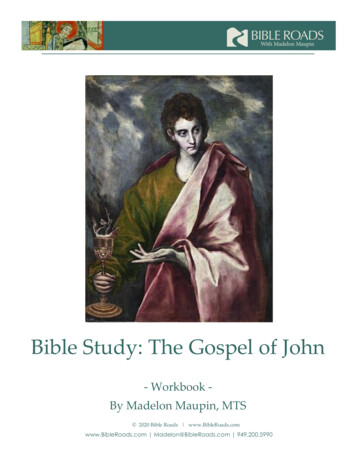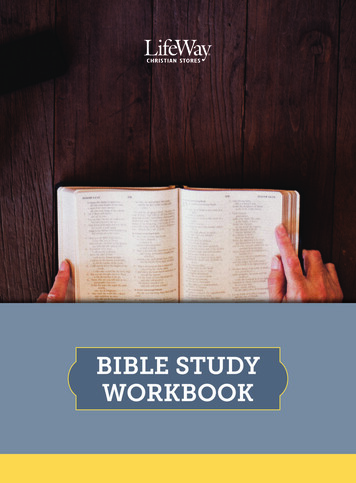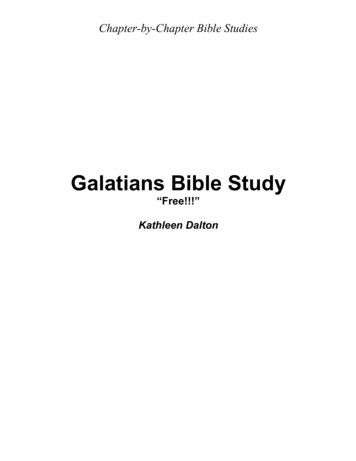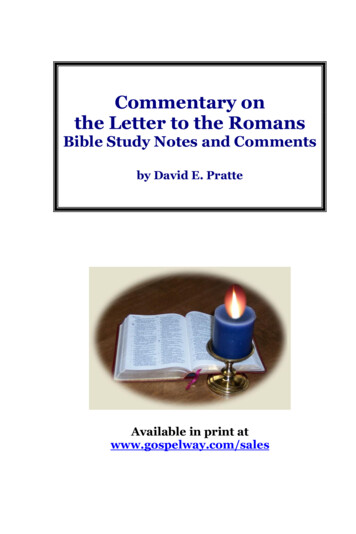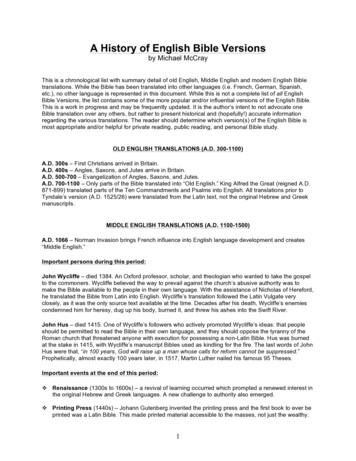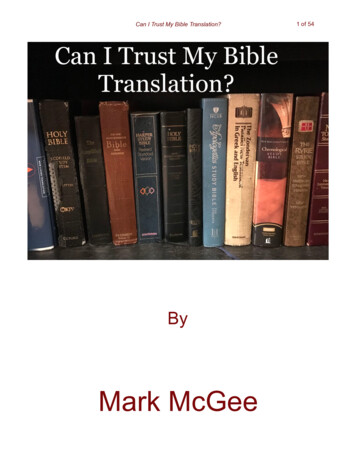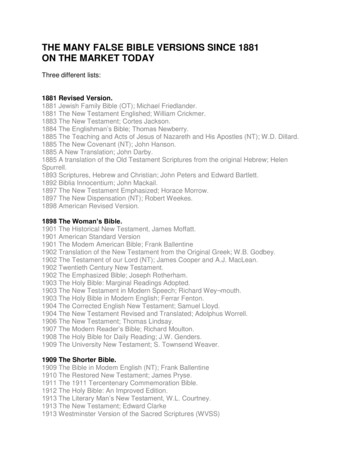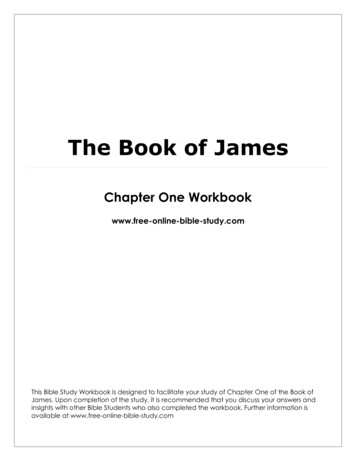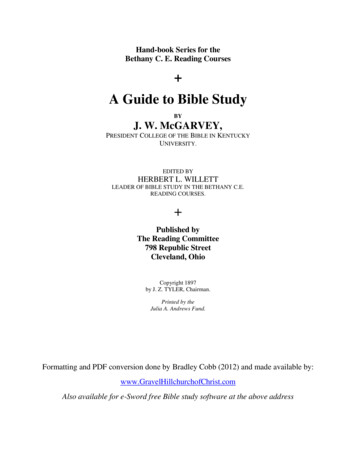
Transcription
Hand-book Series for theBethany C. E. Reading Courses A Guide to Bible StudyBYJ. W. McGARVEY,PRESIDENT COLLEGE OF THE BIBLE IN KENTUCKYUNIVERSITY.EDITED BYHERBERT L. WILLETTLEADER OF BIBLE STUDY IN THE BETHANY C.E.READING COURSES. Published byThe Reading Committee798 Republic StreetCleveland, OhioCopyright 1897by J. Z. TYLER, Chairman.Printed by theJulia A. Andrews Fund.Formatting and PDF conversion done by Bradley Cobb (2012) and made available by:www.GravelHillchurchofChrist.comAlso available for e-Sword free Bible study software at the above address
Table of ContentsTable of Contents . 2Statement of Purpose . 3Introduction . 4DEFINITIONS. 7DIVISIONS OF THE OLD TESTAMENT. . 8THE ORIGINAL TEXT AND ITS PRESERVATION. . 9OUTLINE OF THE PENTATEUCH. . 10ISRAEL'S HISTORY FROM THE DEATH OF MOSES TO THAT OF DAVID. . 13THE REIGN OF SOLOMON AND THE DIVISIONS OF THE KINGDOM. . 16THE TWO KINGDOMS. 18THE KINGDOM OF JUDAH CONTINUED. . 21OTHER PRE-EXILIAN PROPHETIC BOOKS. . 23THE POETICAL BOOKS. . 26THE BOOKS OF EXILE . 30THE POST-EXILIC BOOKS. . 32DIVISIONS OF THE NEW TESTAMENT. . 36THE GOSPELS AND ACTS. . 37THE EPISTLES OF PAUL. . 42THE CATHOLIC EPISTLES AND THE APOCALYPSE. . 49A BRIEF REVIEW. . 53Questions for Each Chapter . 55Appendix . 70
Statement of PurposeThe National Convention of the Disciples of Christ, held in Springfield, Illinois, October 16-23,1896, adopted the following recommendations:"1. That this convention approve the ideas of adding, within certain limits, the educational feature of theChristian Endeavor Societies among us. This added educational feature shall include helps for thesystematic reading of the Bible, a selected course of reading concerning missions in general, and our ownmissions in particular, and thorough instruction as to the origin, the principles, and the history of our ownmovement for the restoration of New Testament Christianity.2. That this convention approve of the purpose to provide a series of hand-books for our youngpeople covering the field not already satisfactorily covered."
IntroductionThe indications of a revival of interest in the study of the Bible are numerous and encouraging.They are to be found in the increase of private and devotional reading of the Scriptures, theimprovement of lesson helps for the Sunday School, the more conscientious preparation of thelesson among teachers in such schools, the increase of exegetical preaching, the organization ofcourses of Bible study in young people's societies in nearly all religious bodies, the increase ofcorrespondence Bible work, the creation of Biblical departments in colleges and universities, theestablishment of Biblical instruction in connection with state universities, and the organization ofclubs and circles for the study of Biblical literature as possessing equal attractiveness withEnglish and other literatures.The study of the Bible is absolutely necessary to the development of the Christian life. The factswhich the Scriptures present are basis of faith in the Christ and in the whole series ofprovidential events which prepared the way for his final disclosure of the life and purposes ofGod. Only by acquaintance with these facts and the prophetic, devotional, and horatorydiscourses and meditations to which they gave occasion is one able to understand the Old andNew Testaments as the records of our holy faith. The necessity of a daily return to the Scripturesas a means of spiritual nourishment and culture is the more apparent when one notes the fact thata great part of our religious life is made up of activities. This is true of the young people, whoseorganizations with their various committees and departments lay emphasis on service; it is trueof the maturer members of the church, before whom is constantly placed the responsibility forthe active ministries to which the gospel calls; and particularly is this true of missionary workers,pastors, teachers and others whose lives are consecrated to Christian service. Where the visibleministries of the church are so largely devoted to the expenditure of spiritual vitality there mustbe some means of nourishment and recuperation. This is provided in the reading and study of theWord of God, and the atmosphere of prayer in which these privileges should be enjoyed. Thenourishment of the Scriptures is as necessary to the spiritual life as that of food to the body.This hand-book is designed to afford suggestion and assistance to those who desire a fuller andmore accurate knowledge of the Bible. It gives a brief summary of facts regarding the makingand the purpose of the Bible; its chief divisions; short sketches of the various books, serving asintroductions to their study; and various other material of an interesting and helpful sort to thereader and student of the Bible. The book has its purposes and its limitations. The former hasbeen noted. The latter was set by the desire to put all the material into such a brief andconvenient form that the little volume could be in reality what its name implies, a hand-book,constantly kept at hand for reference and suggestion.A few suggestions as to a method of Bible reading and study may be found profitable.1. Use the Revised Version of the Bible if possible. It is much superior to the Authorized or KingJames Version, not only because of its better interpretation of particular words and passages, butbecause the translators of 1881-1884 availed themselves of many principles of interpretationunknown to those of 1611. The Revised Version is not perfect, but it is a long advance over itspredecessor and is gradually coming to take its place with those who desire to possess the bestversion of the Scriptures. There may be a feeling of reluctance on the part of those who have
long used the older translation at the thought of giving up its familiar phrases, but one who hasbefore him the most of his career as a Bible student cannot afford to deprive himself of theadvantages resulting from the used of the Revised Version.2. The Bible should be studied with a good map at hand for constant reference showing thelocalities, which were the scenes of the events recorded. If possible some good work on BiblicalGeography should be at hand. One is never able so thoroughly to realize any event of which theBible speaks, i. e., to make it real to himself, as when he visits the spot in person, or by theassistance of good description of the place, or possesses even a map to show its location andrelation to other localities. Almost any good edition of the Bible, either of the Authorized or theRevised Version, contains a set of maps. They should be constantly used till the student isthoroughly acquainted with Biblical localities.3. Some general plan of Biblical chronology should be used for frequent reference. No systemthus far devised is altogether satisfactory, because the writers of the Bible were not particularlyconcerned about dates and give them usually in relation to other events, so that one is often ableonly to approximate the real time of an event. The chronology employed in the margin of theAuthorized Version was that of Archbishop Ussher, and has been found quite unsatisfactory inmany particulars as judged by light thrown, especially on Old Testament events, by recentresearches among the records of nations with which Israel came into contact. An outlinechronology of the leading periods and events in the Biblical history is given in the appendix tothis handbook. Exactness of date is neither possible nor necessary in many cases, but a plan ofdates relatively correct should be mastered by every student.4. The gradual character of the Biblical revelation should be firmly impressed in thebeginning of any study of the Scriptures. The divine purposes were disclosed only as they couldbe understood. A nation was chosen to be the channel of that revelation, and its education was tothat end; not for its own sake, but for the world. The Old Testament is the record of that nationaldiscipline. Not everything could be taught at once, but only step by step could advance be made.Progress is seen through the whole of the Old Testament dispensation in the disclosure of truthand its embodiment in character, in preparation for the appearance of the Christ. The NewTestament is the record of his manifestation to the world; of the gradual spread of the Gospel,and of the helps to the progressive realization of the Christian life.5. The student should seek such familiarity with the books of the Bible that their names,groupings and contents can be instantly recalled. These items are all important. The knowledgeof the names of the books of the Bible in their order is indispensable and easily acquired. Toassist in the possession of this knowledge, and to render it still more accurate and detailed, itshould be remembered that the Old Testament books fall into three groups, which, speaking ingeneral terms, may be called (I) historical, 17; (II) poetical, 5; (III) prophetic, 17; 39 in all. In theNew Testament there are also three groups; (I) historical, the Gospels and Acts, 5; (II) didactic,the Epistles, 21; (III) apocalyptic, Revelation, 1; 27 in all, a total of 66 in the Bible. Then in thestudy of a particular book its plan and contents may be secured. The ability to "think through" abook, i. e., to recall the general line of through its chapters, is the only knowledge that can satisfythe real Bible student.6. The memorizing of portions of Scripture is a practice that should be followed, and whoseresults will be most satisfactory both as a means of a better understanding of the Bible and as
aids to the religious life. The habit of committing to memory a passage of Scripture daily iseasily acquired, and presently the mind is stored with the most precious utterances of the ages.7. References in the New Testament to passages in the Old Testament should be carefullysearched out, and incidents narrated in different places should be compared. This may be donewith the aid of the references found in the Authorized Version, but unfortunately the systemthere adopted often runs to fantastic lengths, references being sometimes given on the basis ofquite superficial resemblance. One's own references, neatly set down on the margins of his Biblein the light of careful study, will always be found the most helpful.8. In short, the ability to do one's own study and come upon one's own results is the goal of allmethods. Notes of work done should be made. Condensations and paraphrases of passages maybe made with profit. "A lead pencil is the best of all commentators." A note-book should be inconstant use. Results may be written on the margin of the Bible page in ink. Many systems of"Bible marking" have been devised. Few are of any value except to those who devise them; butany good method of preserving results, worked out by the student himself, will prove of value.9. The use of any helps that may be within reach is advisable. But they should be used as helps,and not usurp the place of the Bible itself. After all, it is the Bible we are to study, and no merestudy of books can compensate for a failure to study first and constantly the Book.10. The use to be made of this hand-book will suggest itself to every student. In taking up thestudy of any book, read that book carefully. Then read the material on that book in thefollowing pages. After this read the material on the other books of the same group, that thesurroundings of the particular book may be obtained. From these readings a knowledge of itsdate, or that of its events, will be secured, which may be supplemented by the chronologicalmaterial furnished in the appendix. Then read the book through at a single sitting if possible, toget its leading ideas. After this make an outline of its contents, and lastly turn to the questions onthe book in the appendix and write out full answers to them. The results of such a use of thislittle book will render it of value to every one so using it, and will amply justify its preparation.HERBERT L. WILLETT.
Chapter OneDEFINITIONS.The word Bible is derived from the Greek word biblos, which means book. Used as a title itmeans The Book, so called by the way of pre-eminence. This title is not found in the Bible itself;but it came into use among believers after the Bible was completed.The titles, Old Testament and New Testament, also came into use after the completion of theBible. The books which pass under the latter title contain a new covenant which God made withmen, while those under the former contain the old covenant which he made with Israel at MountSinai (Heb. 8: 6-13; Jer. 31: 31-34). In the Latin Bible the word for covenant is translatedTestamentum; and from this, at a time when the Latin Bible was the most read in Europe, the titleTestament came into its present use.The title Scriptures, sometimes with the prefix Holy, is a New Testament title for the books ofthe Old Testament. In II Peter 3: 16 it is also applied by implication to the Epistles of Paul; and itsome came into use as a title for the whole Bible. The word means writings, and in its first senseit could be applied to any writings; but as the expression, The Book, came to mean one particularbook, so the expression, The Scriptures, came to mean The Writings in the Bible. When the termHoly is prefixed, this still further distinguishes these writings.The apostles Paul and Peter both use the title "Oracles of God," for the Old Testament books,and Stephen calls them "The Living Oracles" (Rom. 3: 2; Heb. 5: 12; I Pet. 4: 11; Acts 7: 38). Byoracles is meant utterances of God; and these books were so called, because they containutterances of God through inspired men. They are called living oracles; because of their abidingpower in contrast with the deadness of heathen oracles. But if the Old Testament books areworthy of this title, still more are those of the New Testament; and consequently Papias, aChristian writer of the second century, applies it to Matthew's book, saying, "Matthew wrote theOracles." This is especially true of Matthew, because more than half of his book is composed ofspeeches made by Jesus. It is entirely proper then to speak of the whole Bible as The Oracles ofGod, or The Living Oracles.
Chapter TwoDIVISIONS OF THE OLD TESTAMENT.Every intelligent person knows that the Bible is not one continuous book, but it is made up of anumber of books, differing from one another in subject matter and literary form. Some are booksof history, some of prophecy, some of precept or doctrine, and some of poetry. They are alsodistinguished with reference to the time in which they were written, and the purposes which theywere intended to serve. In order to read them intelligibly it is necessary to take notice of all thesedistinctions.The first five books (let the reader here commit their names to memory if he has not already doneso), are commonly grouped under the title, The Pentateuch,1 a Greek word which means a fivefold book.Next we have twelve historical books, containing a connected history of Israel from the death ofMoses to the restoration after the Babylonian captivity. The reader should commit their names tomemory. Two of these, First and Second Chronicles, repeat large portions of the history given inother books, but they also furnish much additional information.In the middle of our Bible, next after the books last mentioned, we find five books, mostly poetry(commit their names to memory), which are placed without regard to their time of composition.In our Lord's classification of the Old Testament as "the law, the prophets and the psalms," theyare included under the latter title, because the book of Psalms was the best known of the five. Itis now quite common among scholars to include Job, Proverbs, and Ecclesiastes under the title,Wisdom Literature, because of the prominence given in them about wisdom and folly. These fivebooks are grouped together because a likeness in subject matter and literary form distinguishesthem from the others. It should be observed that the arrangement of the books in the Bible is thework of uninspired editors and publishers, and not of the inspired authors.The last division of all is composed of seventeen books which are styled prophetical (committheir names to memory). These, like the preceding division, are grouped together, because oftheir likeness in subject matter. Some of them were written after the Babylonian exile, and somelong before it. They follow one another on the pages of the Bible without regard to the order oftime. Nearly every one indicates in the opening verses the time of its composition by giving thenames of the kings under whom its author lived and prophesied.This classification of the books of the Old Testament, if remembered, as it must be by all whowish to become proficient in Scripture knowledge, will enable the student at any time to readilyturn to the part he wishes to read, whether law, history, poetry, or prophecy. Every part has itsown peculiar value both for instruction and edification; and no part should be neglected.1. Another arrangement includes in one group the first six books. This group, Genesis to Joshua, is usually calledthe Hexateuch.--W.
Chapter ThreeTHE ORIGINAL TEXT AND ITS PRESERVATION.The books of the Old Testament were all written, with unimportant exceptions to be mentionedhereafter, in the Hebrew tongue, which was the native tongue of the Hebrew nation. As theearliest of them were written more than three thousand years ago, and the latest more than twothousand years ago, it is proper to inquire, what assurance we have that our present books are thesame as those in the original collection, and that they contain the same words. To give a fullanswer to these questions would require a whole volume as large as this, but can give theprincipal facts in a few lines.During the period from the first writing of the books till the invention of printing, all copies weremade with the pen, and it has been found impracticable to copy books in this way withoutmaking some mistakes. These occur chiefly in the spelling of words, and in the omission orinsertion of words not essential to the meaning of a sentence; but a few occurred which affect thesense, and which sometimes introduce contradictions of a book with itself, or with another book.Especially is this last the case with names and numbers, in which the copyist had no train ofthought to guide him. This accounts for the discrepancies in numbers which every thoughtfulreader has noticed between certain passages in Chronicles and the corresponding passages in thebooks of Samuel and Kings.After this process had continued until the error of copyists attracted the serious attention ofJewish scholars, a company of them drew up some very stringent rules to prevent such errors inthe future. They counted the number of words in every book by sections, and marked the middleword of every section. Then they required every copyist, when he had copied the middle word, tocount back and see if he had the right number of words. If he had, there was good assurance thathe had omitted none and added none. If he had not, the part written was to be thrown away and anew copy made. These rules were adopted in the second century after Christ, and from that timeforward no errors worth considering crept into the Hebrew Scriptures. When printing wasinvented, which was in the year 1448, and the Hebrew Old Testament was published in thisform, which was in 1477, no more copies were written by hand, and the making of mistakes bycopying came to an end; for when the types for a book are once set up correctly, all copiesprinted from them are precisely alike.The question whether any of the original books have been lost, or others added, is settled by thefact that a Greek translation of the Old Testament was made, beginning in the year 280 beforeChrist, which has come down to our day, and it contains the same books. There can be noreasonable doubt, therefore, that we now have the Old Testament substantially the same as whenits several books were originally written.
Chapter FourOUTLINE OF THE PENTATEUCH.Genesis through Deuteronomy(a) Genesis. It is a singular fact that many of the titles of the Hebrew books are Greek words.This grew out of the circumstance that the ancient Hebrews were not accustomed to giving titlesto their books, but when they were translated into Greek, the translators, according to the customin that language, gave titles to them. The title Genesis (creation) was given to the first book,because it begins with an account of creation.Starting with a brief account of creation, the first general division of this book gives a very fewincidents in the history of our race till the birth of Abraham. This division includes the firsteleven chapters. The events which it records are chiefly connected with the increasingwickedness of men by which God was constrained to destroy all except Noah's family in thewaters of a flood. After the account of the flood there follows an extremely brief account of there-peopling of the earth by the descendants of Noah, and of their unwilling dispersion intodifferent communities through the confusion of tongues. In the course of this brief record, wefind two genealogies--that of Noah, which is traced back to Adam, and that of Abraham, whichis traced back to Noah; and by means of the two we trace back to Adam the ancestry ofAbraham. At the close of chapter eleven the narrative changes from a general history of men, toa biography of a single man. This biography of one man, who lived only one hundred andseventy-five years, occupies one and a half times as much space as the previous history of allmen. We thus discover that the author's main theme thus far is his account of Abraham, and thatthe preceding portion was tended chiefly as an introduction to this.The story of Abraham contains much that is interesting and edifying; and it should be studied inconnection with the many references to it in the New Testament, which are all pointed out on themargin of any good reference Bible; but the chief interest in it to the mind of the author ofGenesis, seems to be centered upon certain promises made to him by God. One was, that hewould give to him and his seed the land of Canaan, in which he was then living as a stranger;another was, that his posterity should be as numerous as the stars of heaven, or the sands in theseashore; and another, that in him and in his seed should all the nations of the earth be blessed. Inconnection with the second of these, he was commanded to circumcise all the males born in hishouse, or bought with his money, and was told that this ordinance should be observed by hisposterity forever. This rite served to distinguish his posterity among men, so that it might be seenin subsequent generations that God's promise was kept. These promises necessarily lookedforward, and the author kept them in mind as he wrote the remainder of this and the other booksof the Pentateuch.In connection with the first of these promises, God told Abraham that before his seed shouldpossess the promised land, they should be in bondage in a foreign land four hundred years, butshould come out a great nation, and then take possession of Canaan. The rest of the book is takenup with the various fortunes of his descendants, many of which are thrillingly interesting, till hisgrandson Jacob, with a family of sixty-eight living descendants, is led by a mysterious chain ofprovidences to take up his abode in Egypt, preparatory to the fulfillment of the last mentioned
prediction. The book closes with the death of Joseph, the eleventh son of Jacob, through whoseinstrumentality the family had been brought into Egypt, and who in dying spoke of the promisedreturn to Canaan, and gave his brethren charge to carry his bones with them for final burial inthat land.A glance backward will now show the reader that the main design of the author of Genesis wasto give the history of Abraham's family down to the migration into Egypt; that the previousaccount of the whole world was preparatory to this; and all this was preparatory to an account yetto be given of the fulfillment of predictions and promises made to Abraham.We find that the author goes over in this short book nearly 2,500 years of the world's history; andyet the book, if printed by itself, would be only a small pamphlet.(b) Exodus. This book is called Exodus (going out), because a prominent event in it is thedeparture of Israel out of Egypt. The name, like Genesis, is Greek. The book is divided into threedistinct parts. The first traces the steps by which the Hebrews, whose coming into Egypt waswarmly welcomed by the king, were finally brought into bondage; and those by which, under theleadership of Moses, they were delivered after a residence in that land of four hundred and thirtyyears. Nearly the whole world had at that time fallen into idolatry; and the method which Godchose for the deliverance of Israel was also intended to make himself once more known to theEgyptians and the surrounding nations, while it also made him much better known to his ownpeople. Moses was the first missionary to the heathen. The second part shows the wonderful wayin which God sustained the people in the wilderness; how he led them to Mt. Sinai; and how hethere entered into a covenant with them, and gave them a set of laws, civil and religious, togovern them as a nation. The third part describes a sanctuary, or place of worship which hecaused them to erect, and which could be easily moved with them through all of their subsequentjourneys. By these events was fulfilled the promise to Abraham, "That nation whom they shallserve, will I judge; and afterward shall they come out with great substance;" for the fulfillment ofthe various promises to Abraham runs like a thread through all the subsequent history of hispeople.(c) Leviticus. This book is filled with a set of laws, regulating the sacrifices and purificationswhich were connected with the worship at the sanctuary, together with a few ethical preceptsintended to cultivate holiness and righteousness among the people. It is because these ceremonieswere to be administered by the priests the sons of Aaron and other Levites, that the book wasnamed by the Greek translators, Leviticus.(d) Numbers. This name was given from the circumstance that the numbering of Israel twice bythe command of God is recorded in it, the first numbering near the beginning, and the secondnear the close. The book gives an account of the journeyings and other experiences of Israel,during the period of about thirty-eight years, in which they were wandering from Mt. Sinai to theeastern bank of the river Jordan, whence they finally crossed over into Canaan. Many of theirexperiences were of the most thrilling character, rendering this a most interesting book. In thecourse of these events many new laws were given, God having reserved these to be given inconnection with events which seemed to call for them, and to this make the enactment of themmore impressive than it otherwise could be. It was a time of wonderful divine discipline, in thecourse of which the whole generation of grown persons who crossed the Red Sea perished, withthe exception of two, and a new generation was brought up under the training of the Lord. These
could be expected to serve God in their new home more faithfully than their
and not usurp the place of the Bible itself. After all, it is the Bible we are to study, and no mere study of books can compensate for a failure to study first and constantly the Book. 10. The use to be made of this hand-book will suggest itself to every student. In taking up the study of any book, rea



